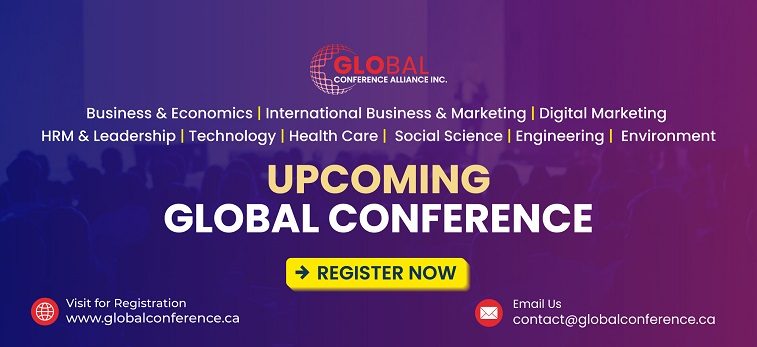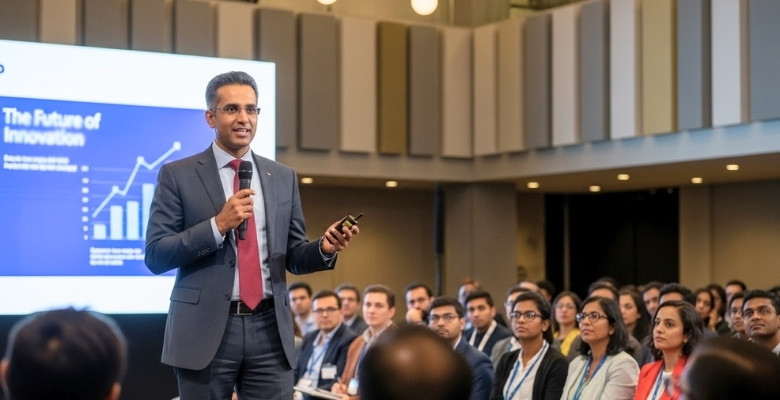Standing in front of a room full of people, the start of a conference presentation often feels like the moment that decides everything. You have their eyes on you, waiting for your first words, and somewhere in your mind, you might be thinking, how do you greet everyone in a conference presentation?
Greet everyone in a conference presentation by smiling, saying “Good morning” or “Hello,” introducing yourself clearly, thanking the audience for their time, and briefly stating your topic. Use a calm tone, maintain eye contact, and speak slowly to build connection and confidence.
Do you want to know the small actions that can make your greeting stand out? Keep reading this article because here you will find every detail you need to make a great start, from tone and body language to practical scripts you can use.
How Do You Greet Everyone in a Conference Presentation?
A good start in a conference presentation makes a big difference. People remember how you begin and how you make them feel. Knowing how to greet in a presentation can set the right tone from the very first moment. A warm and friendly opening will make them more interested in your topic. You can easily win their attention by following a few simple practices.

Start With a Smile to Show Warmth
When you walk to the stage, smile naturally to show friendliness and confidence. A smile instantly helps you connect with people, makes them feel comfortable, and creates a positive atmosphere. It also helps you appear approachable and relaxed before you even start speaking.
Greet the Audience with a Friendly Opener
Begin your talk with a warm, simple greeting. Say something like “Good morning, everyone” or “Hello, it’s wonderful to see you here.” Keep your tone natural and positive. This short opener is the perfect greeting before a presentation as it sets the mood for your talk and makes the audience feel welcome.
Introduce Yourself Clearly and Confidently
After greeting, share your name, position, and relevant background in a confident voice. For example, “I’m Sam Carter, marketing manager at GreenTech Innovations.” A clear introduction builds trust, lets people know who you are, and helps them connect your message with your professional experience.
Thank the Audience for Their Time and Presence
Show appreciation by thanking the audience for attending. Say something like, “Thank you for joining us today,” or “I appreciate your time.” This small gesture shows respect for their commitment and attention, helping to start your presentation with politeness and mutual goodwill.
Introduce the Topic of Your Presentation Briefly
Give a short, clear preview of what you will talk about. For example, “Today, we will explore how smart technology can improve workplace safety and productivity.” This is an approach you can use whether you are speaking at a local event or an international event like conferences in Canada, the USA, or any other country, as it helps the audience know what to expect.
Maintain Eye Contact to Build Connection
While speaking, make gentle eye contact with different people around the room. It shows you value their attention and helps keep them engaged. Avoid staring at one spot for too long. Instead, shift your gaze naturally to create a warm, inclusive atmosphere.
Speak Slowly to Ensure Understanding
Control your pace so your words are clear and easy to follow. Speaking slowly also gives you time to think and helps the audience absorb information. Avoid rushing, especially at the beginning, as a calm speaking speed will make your message more impactful.
Stay Relaxed and Calm for a Smooth Start
Take deep breaths before starting and keep your body language open. Stand with a steady posture and avoid fidgeting. When you are calm, you project confidence and help your audience feel at ease, setting a positive tone for the entire presentation.
A smooth beginning is the key to a successful presentation. Every choice you take should make the audience feel more engaged. Simple actions like smiling, greeting, and making eye contact build trust. When you start well, the rest of your talk becomes much easier.
Ready-to-Use Greeting Scripts for Conference Presentations
Starting your conference presentation with the right greeting makes a big difference. The way you open sets the tone for your entire session. A strong start helps the audience feel comfortable and ready to listen. Greeting the audience in a warm and confident way is the first step to building a connection. Here are some greeting examples for different types of events you may present at.
Formal Greeting Examples for Professional Conferences
Good morning, ladies and gentlemen, and welcome to this important conference session. My name is [Your Name], and I am honored to be here with you today. I truly appreciate you taking the time to attend and join this discussion. Over the next hour, we will explore ideas and strategies I believe are both useful and valuable for our shared goals. I hope you find ………………….
Download the full version here
Informal Greeting Examples for Casual or Small Events
Hello everyone, it’s wonderful to see so many friendly faces here today. My name is [Your Name], and I’m really happy to share some ideas with you. Thank you for setting aside time to join this session and be part of our conversation. We will keep things relaxed, interactive, and enjoyable, so please feel free to jump in anytime. Together, we’ll explore ………………….
Download the full version here
Virtual Conference Greeting Examples for Online Presentations
Good morning, afternoon, or evening to everyone, depending on where you are joining from. I’m [Your Name], and I’m truly happy to connect with you in this online setting. Thank you for logging in and choosing to spend part of your day here with me. My aim is to make this session as useful and clear as possible. Please use ………………….
Download the full version here
Small Group and Workshop Greeting Examples
Hi everyone, and thank you for being part of this workshop today. My name is [Your Name], and I’m looking forward to working closely with each of you. I appreciate you setting aside time to join our small group, as these sessions are perfect for open discussion and hands-on learning. I encourage you to take part, ask questions, and share your ideas freely. Together, ………………….
Download the full version here
How Much Time Should You Spend Greeting Everyone in a Conference Presentation?
Starting your talk with a greeting is important, but it should never take too long. A short, focused opening keeps the audience engaged and ready for your main message. The right timing shows you value both their attention and the schedule of the event, and it’s a key part of knowing how to greet effectively in a presentation. Here’s a time schedule:
| Subheading | Recommended Time |
| Respect the Audience’s Agenda | 30–50 seconds |
| Use a Visual or Slide Timer | 5–10 seconds |
| Balance Energy and Efficiency | 15–20 seconds |
| Let the First Minute Flow Naturally | 45–60 seconds total |
Respect the Audience’s Agenda
When starting a conference presentation, you should keep your greeting short enough to hold attention but long enough to make everyone feel welcomed. Most people attend to hear the main message, not a long opening. Respecting their time shows professionalism and keeps them engaged from the very beginning.
Use a Visual or Slide Timer
Having a small timer on your screen or near your notes can help you stay within the set time. This tool lets you track how long you’ve been speaking without looking rushed. A quick glance ensures you transition smoothly into your main content right on schedule.
Balance Energy and Efficiency
You can be warm and engaging while also moving at a steady pace. Energetic delivery grabs attention quickly, and then you can guide the audience toward your main points. This balanced approach keeps momentum without making your introduction feel longer than necessary.
Let the First Minute Flow Naturally
Even with a short greeting, avoid sounding like you are reading a script. Keep your tone natural and conversational so it feels genuine to the audience. A smooth, natural flow helps your words land better and keeps everyone focused without feeling hurried.
Adjust Based on Room Response
If you see the audience eager to begin, keep things brief. If they appear relaxed and open, you might use the full minute. Reading their body language helps you decide whether to shorten or slightly extend the greeting while still keeping it within a good time limit.
A well-timed greeting sets a smooth tone for the rest of your presentation. Keep it within limits, read the room, and move forward with confidence. When your opening is short and meaningful, the audience stays attentive from the very start.
Comparing Formal and Informal Conference Greetings
Choosing between a formal or informal conference greeting depends on the event’s nature and audience. The right approach helps set the mood, build a connection, and match expectations. This comparison highlights key differences in tone, language, and style to guide your choice.
| Aspect | Formal Conference Greeting | Informal Conference Greeting |
| Best Use | Large-scale events with high-profile guests or industry leaders. | Smaller gatherings, community events, or creative meetups. |
| Tone | Polished, structured, and respectful with clear professionalism. | Relaxed, conversational, and friendly with a casual approach. |
| Language Style | Uses complete sentences, formal titles, and avoids slang. | May include contractions, humor, and light everyday phrases. |
| Body Language | Controlled gestures, upright posture, and steady pace. | Open gestures, relaxed posture, and natural pacing. |
| Setting Examples | International summits, academic conferences, corporate launches. | Startup pitch nights, informal networking events, hobbyist workshops. |
| Example Line | “Good morning, everyone, and welcome to our conference.” | “Hi everyone, great to see you all here today.” |
Matching your greeting style to the event makes a strong first impression. Whether formal or informal, clarity and warmth matter most. Use the right tone, language, and body language to engage the audience from the very first moment.
Essential Do’s and Don’ts for Greeting Everyone in a Conference Presentation
A thoughtful greeting is more than just polite words. It can set an energetic tone, guide the audience’s focus, and prepare them for what’s ahead. By knowing what to do and what to avoid, you can create a smooth start that feels both natural and impactful.
| Do’s | Don’ts |
| Stand in a clear, visible position so everyone can see you. | Avoid blocking the view with notes, podium, or equipment. |
| Use a brief pause before speaking to capture full attention. | Don’t start speaking while people are still settling in. |
| Adjust your microphone or voice level before you begin. | Avoid beginning without checking if everyone can hear clearly. |
| Use a welcoming facial expression that matches your words. | Don’t keep a neutral or tense expression throughout the greeting. |
| Refer to the event or occasion to connect with the moment. | Avoid skipping any acknowledgment of the gathering’s purpose. |
When you start with presence and awareness, your greeting feels genuine. Simple physical cues and clear delivery can make the audience more attentive. Avoid distractions that take focus away from your message. The right start prepares the way for a confident and engaging presentation.
How to Recover If Your Conference Presentation Greeting Goes Wrong?
Sometimes, the start of a conference presentation does not go as planned. You may forget lines, face technical problems, or feel nervous on stage. These moments can feel uncomfortable, but they are easy to recover from. Knowing what to do can help you get back on track quickly, even if your planned salutation for presentation doesn’t go exactly as rehearsed.
If You Forget Your Opening Lines
Losing track of your first words can happen to anyone on stage. Take a short breath, give a calm smile, and reset your mind. Use a simple line like, “Thank you for your patience, let us begin.” Glance at your notes for a short topic cue to continue. Speaking that cue aloud will guide you into your first main point smoothly. The audience will usually forget the small delay once you move forward confidently.
If Slides or the Microphone Stop Working
Unexpected technical issues can interrupt your flow and distract the audience quickly. Acknowledge the problem politely so everyone knows you are aware of it. Continue speaking in a clear voice so people can still follow along. You might explain your first point without visuals until the issue is fixed. If needed, ask those in front to sit closer for better hearing. Staying calm will show the audience you are still in control.
If Your Words Come Out Wrong
Making a slip with words is normal and does not ruin your talk. Smile lightly and restate your sentence in a clearer and simpler way. Use a phrase like, “Let me say that more clearly” before continuing. Keep your voice steady and friendly while you correct yourself naturally. Avoid repeating the mistake or apologizing too many times to the audience. Moving forward quickly will keep attention on your message, not the error.
If Nerves Spike and You Feel Awkward
Feeling nervous is common, especially in the first few minutes of speaking. Take a slow breath, stand with steady feet, and relax your shoulders. Speak your next line at a gentle pace to regain control. Keep your hands still or lightly resting on the lectern while talking. A short pause can also help you collect your thoughts before continuing. Showing calm body language helps your audience feel comfortable and ready to listen.
If the Room Feels Restless or Distracted
A distracted room can make it harder for people to follow your words. Try regaining attention with a quick and simple audience question. Use something related to your topic so it feels natural and relevant. For example, ask, “Who has used this method before?” to re-engage them. Thank anyone who responds and smoothly return to your prepared points afterward. A small interaction can bring focus back without breaking your overall flow.
Easy Restart Approach for Any Situation
Restarting is easy when you have a short, prepared backup plan ready. Begin by thanking the group, saying your name, and stating the topic. Add one sentence on what value they will get from your talk. Share one simple sentence about the plan before moving to your first point. This short structure can be used in almost any presentation situation. It quickly shifts you from a stuck moment into a confident delivery again. Here’s a quick restart script you can use:
“Thank you for your patience. My name is [Your Name], and today I’ll be talking about [Your Topic]. By the end of this session, you’ll have [Main Value or Benefit]. Here’s the plan: we’ll start with [First Point], then move to [Second Point], and finish with [Third Point]. Let’s begin.”
Simple Prep That Makes Recovery Much Easier
Preparing for possible issues before your presentation can save you from panic. Write a single clear sentence that explains your talk in plain language. Keep a small cue card with three key prompts in your pocket. Save an extra copy of your slides on a USB for safety. Practice two short recovery lines until they sound natural and confident. A little preparation can make handling any problem much less stressful during your talk.
Recovering from a rough start is easier than most people think. The key is to stay calm and act with confidence every time. A small pause and a smooth restart can reset the audience’s focus. With practice, you can turn an awkward moment into a strong beginning.
Why Some Conference Presentation Greetings Work Better Than Others?
Certain greetings capture attention and make people want to listen more. The difference often comes from subtle choices made in those first moments. Understanding these elements can help you open in a way that feels engaging, natural, and memorable for the audience.
Using the Right Energy Level
Starting with the right amount of energy helps the audience tune in. Too much energy may feel overwhelming, while too little can seem dull. Finding a balanced level makes your presence inviting without being too intense or flat.
Choosing Words That Connect Emotionally
A greeting works better when it includes words that spark interest or feeling. Phrases that connect to shared experiences or the event’s purpose create a stronger link. This is one of the secrets behind great conference experiences because it builds immediate rapport. People pay more attention when they feel included right away.
Creating a Smooth Flow Into the Topic
Good greetings often lead naturally into the subject without an abrupt shift. Linking the welcome to the first point keeps attention steady. Sudden changes in focus can make the start feel disconnected.
Timing the Opening Well
A greeting that starts at the right moment makes a better impression. Waiting for the audience to be settled and attentive ensures they hear every word. Starting too soon can mean some people miss the beginning entirely.
Showing Awareness of the Environment
The best greetings often acknowledge something specific about the setting. A short comment about the location, weather, or event detail can make the moment feel personal. This awareness shows you are present and engaged with the same space as your audience.
The first words you speak can shape the audience’s interest for the rest of the talk. Thoughtful choices in energy, timing, and awareness make a strong difference. A memorable greeting is the start of a more engaging and successful presentation.
Questions You Can Ask Right After Greeting Your Conference Audience
Engaging the audience early can make your presentation more memorable and enjoyable. Asking a question right after your greeting creates instant interaction and interest. It helps people feel involved and ready to listen to your main points. The right type of question can also set the mood for the rest of your talk.
Ask for a Quick Show of Hands
Inviting the audience to respond physically helps build immediate energy in the room. A simple yes or no question works well to get instant participation. For example, you might ask, “How many of you have attended this conference before?” This quick visual feedback lets you connect with the group right away. It also gives you a sense of their experience level. People often feel more connected after a shared activity, even a small one like this.
Use a Short Prediction Question
Encouraging the audience to guess something related to your topic builds curiosity quickly. You could ask, “What percentage of companies do you think face this challenge each year?” This makes them think actively before you begin sharing details or data. When you reveal the answer, they feel more engaged in the process. A question like this also creates a sense of anticipation in the room. It sets up your presentation in a more interactive and memorable way.
Invite Them to Share One-Word Responses
Keeping answers short allows more people to join in without slowing the pace. A one-word response question makes participation easy and pressure-free for the audience. You might say, “In one word, how would you describe today’s market conditions?” Their varied answers can bring in humor, surprise, or shared insight. This style of question works for both serious and light themes. It shows that every opinion is valued, even in the shortest form possible.
Ask About a Recent Relevant Event
Mentioning something current gives the audience a reason to pay close attention. You could ask, “Who here followed the industry news from last week’s big announcement?” This shows awareness of the wider world beyond the conference. People are more likely to respond when the subject feels fresh and timely. Linking the event to your talk helps your message feel more important. It also encourages listeners to think about how the topic affects real situations.
Use a Light and Fun Icebreaker
Bringing a little humor or creativity into your first moments can reduce tension. You might ask, “If you could attend any event in the world, where would it be?” Even in serious settings, a small moment of fun can create a relaxed mood. A friendly atmosphere encourages people to take part more freely. This approach works especially well in mixed or unfamiliar groups. It can help turn a quiet room into an open, welcoming space quickly.
Starting with the right question can make a big difference in audience engagement. It encourages participation and creates a more relaxed, interactive environment. A well-chosen question can also prepare the audience for the main topic. By setting the tone early, you increase the chances of a successful presentation.
FAQs About How Do You Greet Everyone in a Conference Presentation?
Many people find it tricky to start speaking in front of a large group. A good greeting can make your audience feel comfortable and ready to listen. If you have ever wondered how to greet everyone in a speech, the answer lies in using a warm, clear, and confident opening. Below are some common questions people ask about greeting everyone in a conference presentation, along with simple answers to help you prepare.
How Can I Make My Greeting Sound Natural?
Your greeting sounds natural when you speak like you are talking to a friend, not reading from a page. Avoid memorizing every word of your opening; instead, remember the main ideas you want to share. Use your normal voice tone and add small pauses so your words do not feel rushed. The more relaxed you are, the more natural your greeting will sound to the audience.
What Should I Do If I Am Speaking After Another Presenter?
If someone spoke before you, start by acknowledging them briefly to show respect and connection. You can say something like, “Thank you to [name] for that great presentation.” This helps create a smooth transition and keeps the audience engaged. Then, move into your own greeting and topic without a long gap.
How Can I Make My Greeting More Personal?
To make your greeting feel personal, mention something specific about the event, location, or audience. You could refer to the city you are in, a shared goal, or a recent event related to the conference. This small detail shows that you are aware of where you are and who you are speaking to. A personal touch makes people feel seen and included.
Should I Use Humor in My Greeting?
Humor can be a great icebreaker if it is light, respectful, and fits the event’s tone. A small joke or playful comment can make people smile and feel relaxed. However, avoid humor that could offend or confuse anyone. If you are unsure, keep your greeting friendly but simple instead.
How Do I Greet an Audience That Is Already Talking or Distracted?
If people are still talking, pause and smile until you have their attention. You can use a friendly remark like, “I’ll give everyone a moment to settle in.” This shows patience and keeps the mood positive. Once the room is quiet, start your greeting so everyone hears you clearly.
How Can I Greet People From Different Countries in the Same Room?
When your audience is international, choose a simple greeting in a common language like English, but you can add one or two extra greetings in other languages as a friendly gesture. For example, start with “Good morning” and follow with “Bonjour” or “Hola” if you know the words. Keep it short and cheerful so it feels inclusive without taking too long. This shows respect for the diversity in the room.
Is It Okay to Greet People Before Reaching the Stage?
Yes, greeting people while walking to the stage can make you appear friendly and approachable. A few waves, smiles, or short “hello” to nearby attendees can warm up the atmosphere. Once you reach the front, give your full greeting to the entire room. This makes your introduction feel more connected and natural.
How Do I Adjust My Greeting for a Very Small Audience?
With a small audience, you can make your greeting more personal by speaking directly to them. Instead of a big stage voice, use a warm, conversational tone. You might even greet some people by name if you know them. This creates a close, friendly feeling that works well in small groups.
How Can I Keep My Greeting Short but Still Friendly?
To keep your greeting short yet warm, focus on three parts: a hello, a thank-you, and a quick lead into your topic. For example, “Hello everyone, thank you for being here. Today, we’ll look at…” This keeps it under a minute while still showing warmth and professionalism. A short greeting works well when time is limited.
Bottom Line
A good start in any conference talk is about being friendly, clear, and confident. Smile naturally, greet warmly, introduce yourself briefly, thank the audience, and set up your topic in a short, clear way. If you follow these steps, you already know the simple answer to “how do you greet everyone in a conference presentation?”
Once you have greeted well, focus on keeping the energy alive as you move into your main points. Keep your timing in check, use natural body language, and adjust based on audience response. Prepare in advance, stay calm, and enjoy the moment. Wishing you the best for your next presentation.








